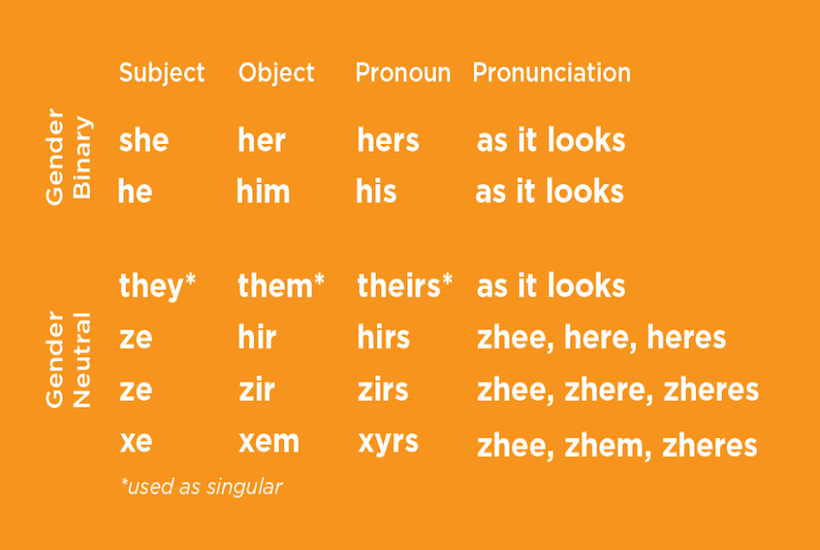Is it he or she? Him or her? In the real world away from the keyboards and our smartphones, gender pronouns are simple, and they don’t have to be complex. But simplifying gender pronouns to apparent, and therefore unconfirmed, biology is just as confusing as the transtrenderism of trying to turn the plural pronouns ‘they’ and ‘them’ into gender-neutral pronouns. Let me explain…
Gender pronouns were essentially the topic of YouTube debate between Ben Shapiro and US transsexual conservative commentator Blaire White earlier this month. Indeed, it was pleasing to see a civil conversation between the two conclude amicably, given that if it was between Ben and a transwoman other than Blaire, chances are, this would have not been so.
Ben argued that in public discourse over transgender issues, it is important to maintain the use of gender pronouns to match the ‘biological sex’ of the trans person(s) concerned because this ensures the integrity of the objective and historical truth in this matter. For example, I, as a transwoman, should be referred to as ‘he’ and ‘him’ due to my ‘biological sex’ based on physical examination at birth: male.
Biological sex, however, is not a straightforward matter, and certainly not as simple as merely XX and XY. That’s because one to two per cent of the general population (and maybe more) are intersex, where an intersex person’s chromosomes may not be typically female (XX) or male (XY). Further, their genitalia may be ambiguous, and their gonads may be atypical. For example, there are people out there with a combination of XY chromosomes, (internal) testes, a vulva, a vagina, female secondary sex characteristics, and male hormone patterns – people with this combination may or may not present as women.
Therefore saying, or implying through use of certain pronouns, that someone is a particular biological sex is assuming a lot about his or her biology, unless you’re their doctor. I myself think I have XY chromosomes due to my initial birth certificate and what I see or used to see on my body, but I can’t be too sure myself as no doctor has ever approached me to advise that I’m intersex (or not).
Of course, this doesn’t change the fact that there are only two genders as explained in my previous opinion piece. Intersex pronouns do not exist, because in everyday language we don’t use gender pronouns other than male and female pronouns to refer to intersex people, and people in general for that matter. Intersex is not a ‘third sex’ because virtually all intersex conditions compose of combined characteristics of both the male and female sexes – hence the term intersex.
The objective truth, based on historical practice, is that male and female pronouns are derived from (male and female) gender presentation, and what is biologically apparent or confirmed, may or may not be a contributing factor to gender presentation. My argument that gender pronouns are derived from gender presentation is not an attempt on my part to redefine biological reality because even if what is biologically apparent or confirmed is not a contributing factor to gender presentation, sex biology remains relevant as ever.
Factoring in the intersex phenomenon, biology nevertheless gives rise to what appears to be one of the two sexes of male and female, and gender describes the (sometimes imperfect) manifestations of what appears to be the male sex or female sex. This allows us to see the differences between male and female. When you see, hear or interact with a man or woman (intersex or not), you pick up gender cues that when subconsciously aggregated, will lean towards either male or female presentation, thereby giving you the two genders: male and female. Essentially, gender is not biological, but it is biologically-driven to degrees of maleness and femaleness, and nothing other than degrees of maleness and femaleness.
Gender cues include many factors, some of which are biologically-driven. This includes the accepted gender of names, observed state of dress (or undress) of the man or woman, general behaviour, natural or hormone replacement therapy-driven secondary sex characteristics, and surgery (if any). You don’t choose pronouns, rather, pronouns choose you depending on your gender presentation, and gender presentation may have a lot or little to do with apparent biological sex. Again, non-biologically-driven factors do not have degrees of something other than maleness and femaleness.
Going back to the YouTube debate between Blaire White and Ben Shapiro: Blaire presents as a woman (for all intents and purposes) very convincingly. But even if she didn’t in a way that resulted in equal amounts of maleness and femaleness in presentation, Ben’s deliberate avoidance of using male or female pronouns to refer to Blaire was also an avoidance of applying common sense.
It was confusing to watch Ben unnaturally use ‘Blaire’ as a pronoun, just as it would be confusing for anyone to refer to Blaire using male pronouns. The dysfunctional use of ‘Blaire’ as a pronoun is an offence to grammar, just as the dysfunctional use of they/them as gender-neutral pronouns is an offence to grammar. Any dysfunctional pronoun use is manifestly unfair to the audience trying to make sense of the trans phenomenon. Dysfunction is not progress.
So is it he or she? Him or her? Gender presentation is your best bet (does the person appear to lean towards male or female?) because biology can be a messy business, and everyday language needs to remain efficient for the real world, grounded in common sense, and free from political correctness.
Biography: Libby DownUnder is an Australian video blogger and writer on social media (mainly Facebook and Twitter). She is a transsexual woman who describes her political views as Conservative Libertarian.
Got something to add? Join the discussion and comment below.
Got something to add? Join the discussion and comment below.
Get 10 issues for just $10
Subscribe to The Spectator Australia today for the next 10 magazine issues, plus full online access, for just $10.


























Comments
Don't miss out
Join the conversation with other Spectator Australia readers. Subscribe to leave a comment.
SUBSCRIBEAlready a subscriber? Log in